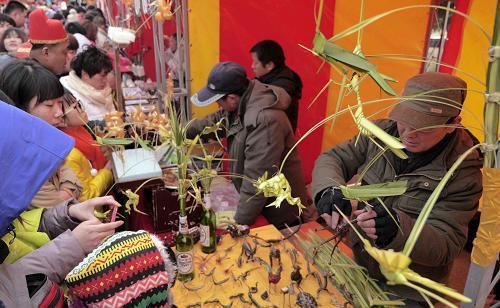
File photo
Miaohui, or temple fair in English, has developed into a major cultural event held during the Spring Festival holiday period as part of Chinese New Year celebrations.
Also called a "temple market" or "jiechang (outside festival)," temple fairs are also commonly held as part of religious activities paying tribute to gods and immortals. However, it is the Spring Festival temple fair that remains the most well-known and popular one across China.
Events at temple fairs can be divided into three types, religious ceremonies, entertainment events such as traditional folk games and performances, and trade activities.
As the times have changed, temple fairs have begun focusing more on acting as a platform for demonstrating traditional Chinese folk performances such as the lion dance, martial arts and acrobatics, as well as exhibiting folk handicrafts.
In 2008, a series of temple fairs were incorporated in the National Intangible Cultural Heritage List by the State Council, China's cabinet.
Origin
As the name shows, temple fairs got their start around temples, places where the faithful burn incense and pray to the gods.
The large amount of traffic around temples, especially around religious holidays, made them the perfect commercial opportunities for enterprising vendors, who would set up stalls outside temples to sell all types of items to those coming to pray. Over the centuries, these temporary markets evolved into fairs with scheduled activities and entertainment events for the masses.
A traditional part of temple fairs, religious ceremonies can be roughly divided into five categories.
The first category involves ceremonies paying tribute to one's ancestors and figures from ancient legend, such as Fu Xi, one of the Three Sovereigns of ancient China, or from myths, such as Nuwa, the goddess who created mankind.
The second and third categories deal with the worship of Buddhist deities such as Avalokitesvara and Taoist gods such as the Jade Emperor, the Supreme Deity of Heaven.
Heroes from classic literature and folk legends can also be honored, such as the Monkey King, who most famously appeared in the Ming Dynasty (1368-1644) novel Journey to the West, one of China's Four Great Classical Novels. These types of activities account for the fourth category.
The last category involves praying for blessings from certain special gods such as praying to the immortal of Lishan Mountain in order to get pregnant or Caishen (God of wealth) for good fortune when it comes to money matters.
At present, temple fairs remain a symbol of traditional culture, but are increasingly less focused on religious activities than on tourism, sightseeing, entertainment, shopping and dining.
Regional differences
As part of folk culture, temple fairs are closely linked to local culture, including a place's history and geography, as well as local customs and aesthetic standards.
For this reason, different places over China have their own unique temple fairs.
Temple fairs are still an important part of Beijing for older residents, who prefer to buy their daily necessities and Chinese New Year goods at fairs instead of at shopping malls.
Chenghuang Temple in the city's Xicheng district enshrines Beijing's patron saint. This temple is widely considered the birth place of temple fairs in Beijing.
The Chenghuang temple fair reached its peak during the Ming Dynasty. It was a huge event that got the entire city astir. It was on par with the biggest annual event, the Lantern Festival.
The temple burned down during the latter part of the Qing Dynasty (1644-1911), but the temple fair remained as an annual event for the Spring Festival.
Finding love at the fair
Some areas in Yan'an, Northwest China's Shaanxi Province, hold engagement temple fairs twice a year, one during the fourth month and another during the seventh month of the traditional Chinese calendar.
The day of the fair, matchmakers arrange meetings between two families. The man's family is supposed to bring a present such as watermelon or apples for the woman's relatives to snack on.
If the two potential partners find themselves interested in each other, the two move somewhere more private, while the rest of the family members stay and chat with each other.
Legends from the fair
The South China Sea God Temple Fair is the biggest traditional fair in Guangzhou, South China's Guangdong Province.
One tradition at the fair that has persisted over its 1,000 year history is the Boluo rooster, a handicraft rooster modeled after a famous rooster from local legend.
According to the story, an old woman owned a rooster that had beaten a rich man's rooster during a cockfight. The man stole the woman's rooster, but from then on the bird would not crow in the mornings. Furious at the rooster's behavior, the man killed it.
Heartbroken over the death of her beloved fighting cock, the woman gathered its feathers together and used them to make a feathered clay rooster.
To her surprise, she heard the clay figurine crow when the sun rose the next morning.
Email: lansuying@nbd.com.cn


 川公网安备 51019002001991号
川公网安备 51019002001991号





